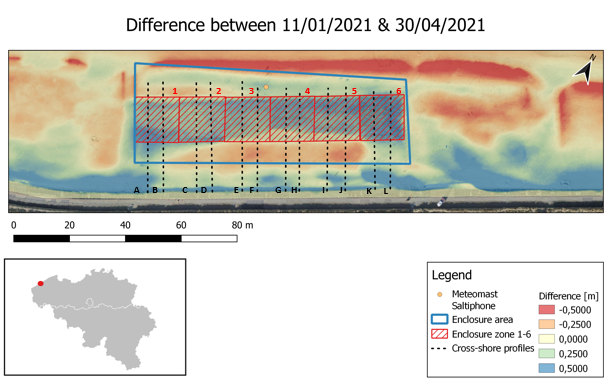J. Derijckere1*, G. Strypsteen1 and P. Rauwoens1,
1Hydraulics and Geotechnics, Department of Civil Engineering, Bruges Campus, KU Leuven, Spoorwegstraat 12, 8200 Bruges, Belgium.
*corresponding author:
Introduction
During strong wind conditions, wind-blown sand accumulates on the local Spinoladijk, blocking an important access road to a leisure beach club. Cleaning this dike is labour-intensive, expensive and unsustainable. To mitigate the sand nuisance, a dune-in-front-of-a-dike solution was implemented. The traditional sea dike is strengthened with the aid of a nature-based solution by creating an artificial dune seawards of the seawall. Benefits are a higher level of coastal safety and at the same time a more natural vision and higher ecological and socio-economical values. There are still some knowledge gaps in arranging such solutions (Rizvi and Riel, 2020). In this study, we want to identify specifically the optimal plant density to protect the dike from sand nuisance, and how these plants are best arranged.
Methods
To find out how dunes can be deployed as a coastal protection measurement by using a dune-in-front-of-dike concept, a new engineered dune was built at Ostend Oosteroever, Belgium. A dune of 2400m² was divided in six zones (1-6) of 20x20m² each with a different density (6, 9 and 15 plants/m²) and planting strategy (regular, clustered and staggered) (Figure 1). By weekly monitoring the topographical changes on 12 cross-shore profiles (two per zone) combined with monthly drone surveys, conducting aeolian transport measurements and simultaneously measuring wind conditions, the effect of density and planting strategy during the initial months (January-April 2021) of dune development is studied.
Results
Results show a clear difference in cross-shore profile development for the different zones, in which the influence of the density is much more prominent than the pattern. Deposition occurs higher and over a shorter distance with increasing density. At the end of April, zone 4 (9 plants/m² staggered) had the most growing potential (no deposition across the last 2.50m in landward direction). The overall volume of sand accumulated in the dune area is increasing in time and is independent of density and planting strategy, hence completely governed by the aeolian sand supply from the beach. The largest volume change corresponds to the strongest wind conditions (6-8m³/m dune growth at the end of April).

Figure 1: Dune-in-front-of-a-dike pilot site at Ostend Oosteroever, Belgium divided in 6 zones and 12 cross-shore monitoring profiles.
References
Rizvi, A.R., Riel, K. Van, 2020. Nature Based Solutions for Climate Change Adaptation – Knowledge Gaps.
I. Surname1*, F.N. Another-Surname2 , Y. Next-Surname2
1 University Name, Country; 2 Organization Name, Country
* Corresponding author: mail.name@organization.org


